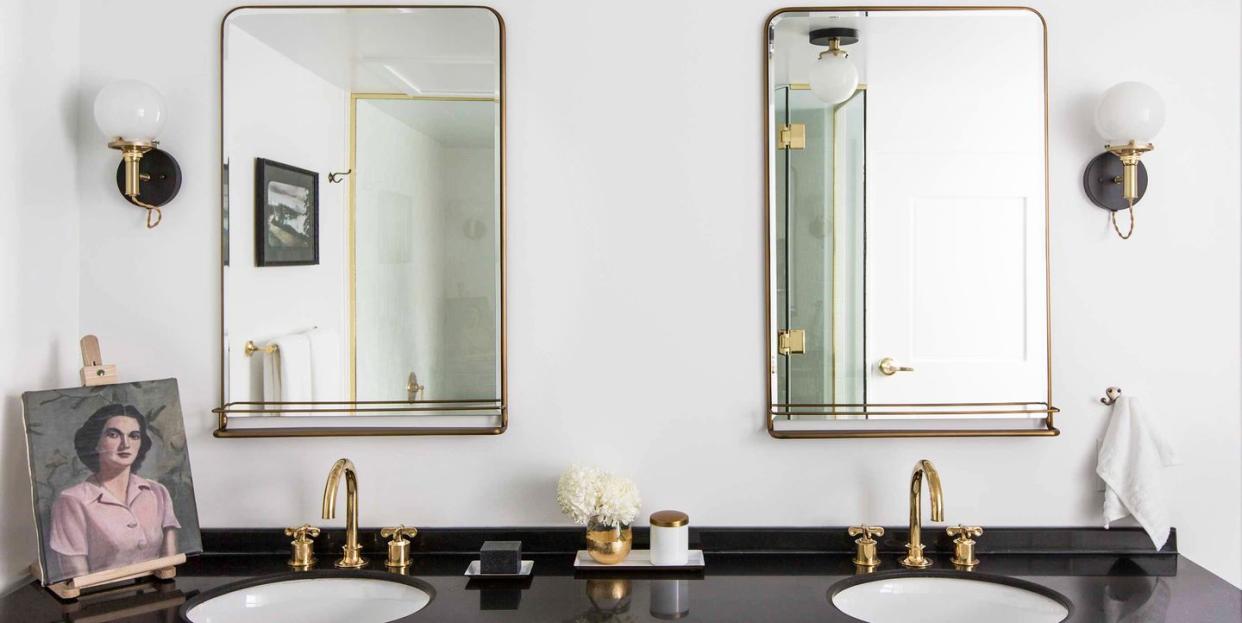How to Create a Well-Lit Bathroom (It's Not Rocket Science)

Toilets and showers aside, finding the right light is the most crucial thing in a bathroom. It makes morning and evening routines better (no accidental Joker makeup moments when task lights—more on those in a second—optimize your vision) and it also sets the mood. But what actually creates the best bathroom lighting? Though we wish it were as easy as screwing in a light bulb, there's actually a lot to learn, from how to choose the right kind of bulbs to which style options are best for what tasks and defining key terms. Keep reading for a complete guide to the best type of bathroom lighting, made easy. Bright ideas ahead.
Use-Case and Moods
A well-lit bathroom includes multiple light sources with distinct purposes—if someone is putting on makeup up or putting in contact lenses, they'll need bright, direct light for optimal vision, for example, but that may too harsh for other activities. Find the main types below:

Ambient: This usually refers to the overhead lighting, which should fill the space with a soft but bright light that mimicks daylight. It usually involves multiple fixtures, depending on the size and scale of the bathroom. Equipping these with dimmers will provide the ultimate custom experience, too. If you do install dimmers, just make sure you choose bulbs compatible with dimmers, otherwise you'll shorten their lifespans.
Task: A bit self-explanatory, but these lights are specifically intended to make bathroom tasks easier by brightening the area around your vanity and mirror and near the shower and/or bathtub. Function over form wins in the case of task lighting—they need to work.
Accent: This is where design comes to shine. Since bathrooms don't have as much opportunity to make decorative statements aside from choosing your materials, wall decor is your best bet. That means mirrors and accent lights.
Natural: Lucky you, if you have it!

Bulb Types and Brightness
Compact Fluorescents: Avoid these! Just like their tubular sisters (those skinny blinding tubes that remind you of standardized test-taking lighting), CFs are simply unflattering. Like, grocery store security camera levels of unflattering. Thats because the blue light tends to enhance all those imperfections that a soft glow flatters. So if your bathroom has fluorescents, you may want to consider swapping those out.
Standard Incandescent: When shopping for these, make sure you read the fine print. Check to see if they're labeled "cool white" to ensure that they won't cast a yellow-y glow. Those won't have the right color index for detail-oriented tasks that require precision and great vision, which is why white is better. These are also sometimes referred to as halogen bulbs.
LED: These use the least amount of energy, You'll want to choose bulbs within the 4000K to 6500K color temperature range (the latter mimicking super bright white daylight, so some might people feel like that's way too bright, especially for ambient lighting). They come in a variety of shapes and sizes, from globes to flame-tipped and classic bulbs. They also use the least amount of energy, so flattery and vanity aside, these are the best for the environment.
Designs and Styles
Sconce: Secured to the wall, sconces are great because they serve double duty: accent and task, which is why you see them in so many bathrooms.
Chandelier and pendants: A chandelier can look beautiful over a bathtub. They can also function as tasks lights if you maneuver them to provide overhead lighting in the right place.
Flush-mount: These lights are mounted into the ceiling instead of hanging down like a pendant or chandelier does. They strike a nice balance between decorative pendants or chandeliers and hidden recessed lights.
Recessed: These work best in the shower since wet zones tend to splash fixtures. If they're enclosed and built for wet conditions, they'll keep water out (safety, first!). They're fixed into a ceiling and cast light down from overhead.
You Might Also Like

